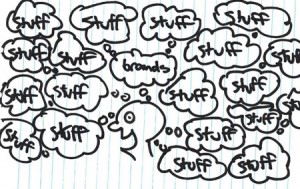What Little I know about Branding
A promising start

Over the past decade thousands, perhaps millions of words have been written about Branding. From early history man has rallied behind pennants, flags, and assorted symbolic attachments such as the Roman Aquila – the eagle which acted as both motivator and protector. As long as the banner stood proud, the battle went on.
And it is not simply early historic no less, the symbolism continues in our recent history which is perhaps best personified by the well known photograph of the ‘Raising the Flag on Iwo Jima’ which depicts U.S. soldiers raising the Stars and Stripes in an act of defiance to the Japanese.
Today, we see branding in its commercial reality, maintaining the same motivational, protectionist role but with less tragic consequences. What little I know about branding is founded on what I call its ‘profound mystery’. I neither understand why it is so badly disrespected by some or dismissed so easily by others. I know it to be a long term cure and a mid term remedy, a powerful deterrent for the immemorable. and a powerful ally of extraordinary proportions to sales.
I am often asked, ‘should a brand have a meaning, should it represent something or is it just a con?’ The answer of course lies in what you believe a brand is. Is it a pretty picture which identifies you or your product? Is it representative of what you believe in or the ultimate demonstration of the promises made? Yes, what little I know about branding is based on what works and what doesn’t and in conclusion, perhaps I can state with real experience what I know, in the hope that the reader might put two and two together and arrive with the right answer. Someone recently wrote in commenting on one of my colleagues’ branding blogs, “The Labor Party has a logo which is OK, but its brand is toxic”. If they are indeed correct, it does perhaps assist in defining what a
brand is.
A brand, by perceptive inclination – that is by how our perception forms the building of our opinions is tentative and fragile. If we engage the trust switch we can believe a company or a product behaves in a specific way and we build our expectations around those perceptions. In other words, we believe the promise the company, product or service offers. Anything which contradicts that promise is viewed with suspicion and can be considered a ‘breach of trust’. Do it enough and your brand trust is destroyed. The logo becomes inconsequential and suddenly your brand is ‘toxic’. In logical conclusion it would appear therefore that a brand is a promise and a brand is you. Break the promise and you destroy the belief system which created the trust and at that point toxicity sets in.
To conclude, it seems sensible to me that any organisation needs to carefully exam its brand and ask the question, “Does my brand promise more than it can deliver? Do our people live the dream and can they deliver?” If the answer comes up less than 100% Yes, you may have a problem!
In Disneyland you can only be fired for a few reasons, the most important one is “Breaking the Dream”.
That’s how little I know about branding.
